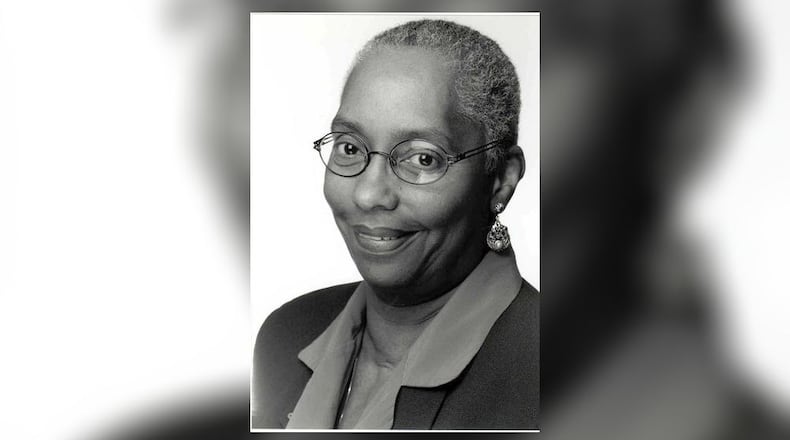“I thought it would be a good thing for the alumni group to be involved in – honoring Jeraldyne on a stamp,” Ward said. “Jeraldyne was a great lady. She created a wonderful dance company. There is still immense pride in the dancers who danced for her over the years. There’s also a local element that is so inspiring not only young people but all people. Jeraldyne was of this soil: Dayton, Ohio. She had many gifts and remarkable vision. She could have built her dance company anywhere in the United States but she chose to stay here among the family and friends she grew up with. She also had a large impact out of Dayton, Ohio as well.”
In 1948, Blunden began dancing at the age of 8. She attended the Linden Center Dance School, an African American Community Center taught by Josephine and Hermene Schwarz, founders of the Dayton Ballet. At 19, Blunden became the director of dance classes at the Linden Center. In 1963, she started Jeraldyne’s School of Dance. In 1968, during the height of the civil rights movement, she founded DCDC, the oldest modern dance company in Ohio, which offers the largest repertoire of modern dance works by African American choreographers in the world.
Blunden’s numerous awards and commendations include: the John D. and Catherine T. MacArthur Foundation Fellowship Award; The Katherine Dunham Achievement Award; the Dance Magazine Award; the National Black Festival’s Lifetime Achievement Award; the Dance/USA 2000 Honors Award (posthumously); and honorary doctorates from the University of Dayton and Wright State University.
Ward still recalls the valuable lessons learned under Blunden’s tutelage, especially the significance of executing to the fullest in rehearsal in order to excel to the highest degrees in performance.
“It’s in the work,” he said. “What you put on stage is always so important. You have to make sure you work toward that end in the studio when you’re practicing movement in the studio or choreographing. The ultimate product is the result of all the serious hours you put into pieces in the studio.”
Ward also noted Blunden emphasized the importance of relationship-building.
“People really matter,” he said. “The young dancers, the older dancers, all the people you come in contact with day after day matters. How you relate to everyone and have relationship with them really matters. That’s what living is all about and what the art is all about.”
Inside the process
The Citizens’ Stamp Advisory Committee in Washington, D.C. is responsible for selecting subjects for recommendation as future stamp issues. There are four steps in the process: 1) Carefully consider the criteria for appropriate stamp subjects; 2) Submit your proposal in writing by U.S. mail; 3) Include pertinent historical information and important dates associated with the subject in your proposal; and 4) Mail your suggestion to the committee.
DCDC is committed to obtaining 10,000 signed letters. Submitting such a large number of letters isn’t required but Ward felt it would indicate overwhelming support.
“We set the goal to impress,” he explained. “We want as many people from all walks of life – artist, student, senior, politician, non-arts, every color – to participate.”
Credit: Hiromi Platt Photography
Credit: Hiromi Platt Photography
As Ward oversees this endeavor, he has received key assistance from Patricia Day, a Richmond, Virginia native who served over 40 years with Dayton Public Schools (DPS) as a social studies teacher and administrator.
When Day moved to Dayton in the early 1980s, she befriended Blunden as well as Blunden’s parents when she became a member of Phillips Temple Church. When she attended DCDC’s “Musicology” concert at Sinclair Community College in October, she found out about the opportunity to sign a letter of support for Blunden to be recognized on a U.S. postage stamp. She couldn’t say no.
“I’m all about community service and doing what I can to make a difference,” said Day. “I signed the letter but on my heart, and in retirement, I began to think I could do more. As an old-school campaigner who doesn’t do much on social media platforms, and who believes in the philosophy of ‘each one, reach one,’ my heart was directing me to speak with the DCDC staff to see if I could make a difference.”
After meeting with the company last December, Day found herself at the forefront of the mission to collect 10,000 signed letters, going out into the community from churches and libraries to restaurants, beauty shops and barber shops.
“A lot of my encounters have been divinely inspired,” she exclaimed. “It’s been amazing and I have been in awe.”
Educating the next generation
Day’s various community meetings involved discussions with DPS, particularly school board members. The idea of getting staff and students to bolster community support seemed a perfect fit considering Day’s history with the school district writing curriculum during the tenure of DPS Superintendent Percy Mack.
Using the English language arts as the primary discipline to run the threads of the lessons and activities for grades Pre-K through 12, she conceived four main points: 1) Jeraldyne Blunden and contemporary dance; 2) African Americans who have been honored on a U.S. postage stamp; 3) The multiple intelligences akin to STEM (Science, Technology, Engineering and Mathematics); and 4) Align the lessons with the state standard model curriculum.
Credit: CONTRIBUTED
Credit: CONTRIBUTED
“The children will be able to use critical thinking skills from analyzing to synthesizing,” Day explained. “For example, one lesson would ask the students to compare and contrast two African Americans who have already been honored on a stamp. Another example would ask the students to design a video comparing contemporary dance to hip-hop.”
At the end of January, a professional development session was held for Teacher Leaders to educate them about the life of Blunden and provide ideas for incorporating her legacy into classroom activities for all grade levels throughout February. DPS educators will be incorporating Blunden’s legacy into their lessons as students learn about who she was, different styles of dance, and even participate in the letter-writing campaign.
“We are proud of Jeraldyne Blunden’s legacy as a 1958 Roosevelt High School graduate,” said DPS Superintendent Elizabeth Lolli. “We are looking forward to both supporting DCDC’s letter-writing campaign and educating students about an important historical figure to the Dayton community.”
Credit: JAN UNDERWOOD
Credit: JAN UNDERWOOD
Each week, Day says she submits signed letters to Ward. As of Feb. 14, the overall total collected is 4,969. DCDC would like to receive all signed letters from the community by June 30, which marks the end of the company’s 54th season.
“This stamp campaign is important for Dayton, for Ohio and the United States,” said Day. “Jeraldyne left a rich legacy and DCDC is world renowned. This (campaign) is a statement to show Dayton is still making a difference culturally.”
“Pat Day has been a godsend,” Ward added. “She has so much energy and inexhaustible resources. The work she has done has been fantastic and we are grateful to have her support.”
‘She became an iconic visionary’
Carrying the mantle as DCDC artistic director, Debbie Blunden-Diggs is pleased that the community has rallied behind another endeavor honoring her mother. Last December the city of Dayton renamed a portion of Norwood Avenue after Blunden. As the stamp campaign continues, especially during Black History Month and Women’s History Month in March, she recognizes the magnitude of her mother’s legacy and the importance of this large-scale recognition.
“This (campaign) reminds me that she belonged to the world,” said Blunden-Diggs. “All her awards and accolades say that on a national level. But this also reminds me she was bigger than even I understood. For me, growing up, she was first of all my mother. And then she became an iconic visionary in Dayton and then regionally, nationally and internationally. This just gives place and space to be able to honor that.”
Credit: JAN UNDERWOOD
Credit: JAN UNDERWOOD
Ward is confident Dayton will be proud to see themselves in Blunden’s commemoration. If chosen, she would join fellow African American dance luminaries Alvin Ailey (2004), Katherine Dunham (2012) and Gregory Hines (2019).
“(DCDC) firmly believes in Jeraldyne’s quote: ‘Man has created boundaries for race, religion and culture. If we can get past that, we can realize there is much in life which connects us,’” said Ward. “She put that into play in her art, her life and to those she impacted. This stamp represents a moment in which Daytonians, young and old, see themselves honored in this national way.”
How to join Jeraldyne Blunden commemorative stamp campaign
Those who wish to participate in the letter-writing campaign to help DCDC collect 10,000 signed letters can visit www.dcdc.org and download the pre-written letter available on the homepage. The letter should be printed, signed with ink, and mailed to DCDC at 840 Germantown St. Dayton, Ohio 45402.
Stamp subject selection criteria
According to the U.S. Postal Service’s Citizens’ Stamp Advisory Committee, there are 11 criteria for stamp selection.
1. U.S. postage stamps and stationery will primarily feature American or American-related subjects. Other subjects may be considered if the subject had significant impact on American history, culture or environment.
2. The Postal Service will honor extraordinary and enduring contributions to American society, history, culture or environment.
3. U.S. stamp programs are planned and developed two to three years in advance. In order to be considered, subject matter suggestions should be submitted three or more years in advance of the proposed stamp.
4. Living people will not be considered at the present time. Beginning in 2018, proposals for a deceased individual will be considered three years following his/her death.
5. A memorial stamp will be issued honoring U.S. presidents after they are deceased.
6. Events of historical significance shall be considered for commemoration on anniversaries in multiples of 50 years.
7. A balance of stamp subjects that includes themes of widespread national appeal and significance will be considered for commemoration. Official postal cancellations, which may be arranged through the local postmaster, may be requested for significant local events or commemorations.
8. Commemorative postage stamps will be issued at intervals of 50 years from the date of the state’s first entry into the Union.
9. The stamp program commemorates positive contributions to American life, history, culture and environment; therefore, negative occurrences and disasters will not be commemorated on U.S. postage stamps or stationery.
10. Due to the limitations placed on annual postal programs and the vast number of locales, organizations and institutions in existence, it would be difficult to single out any one of the following for commemoration: government agencies, localities, non-profit organizations, associations, and similar entities. Stamps or stationery items shall not be issued to honor religious institutions or individuals whose principal achievements are associated with religious undertakings or beliefs. However, these subjects may be recognized with commemorative postmarks.
11. Stamps may be issued for the five active-duty branches – Air Force, Army, Navy, Marines, and Coast Guard. This includes Reserve/Guard components of the current organizational structure. Stamps for the major service academies will be considered on a case-by-case basis for 50-year anniversaries (or multiples thereof).
About the Author







